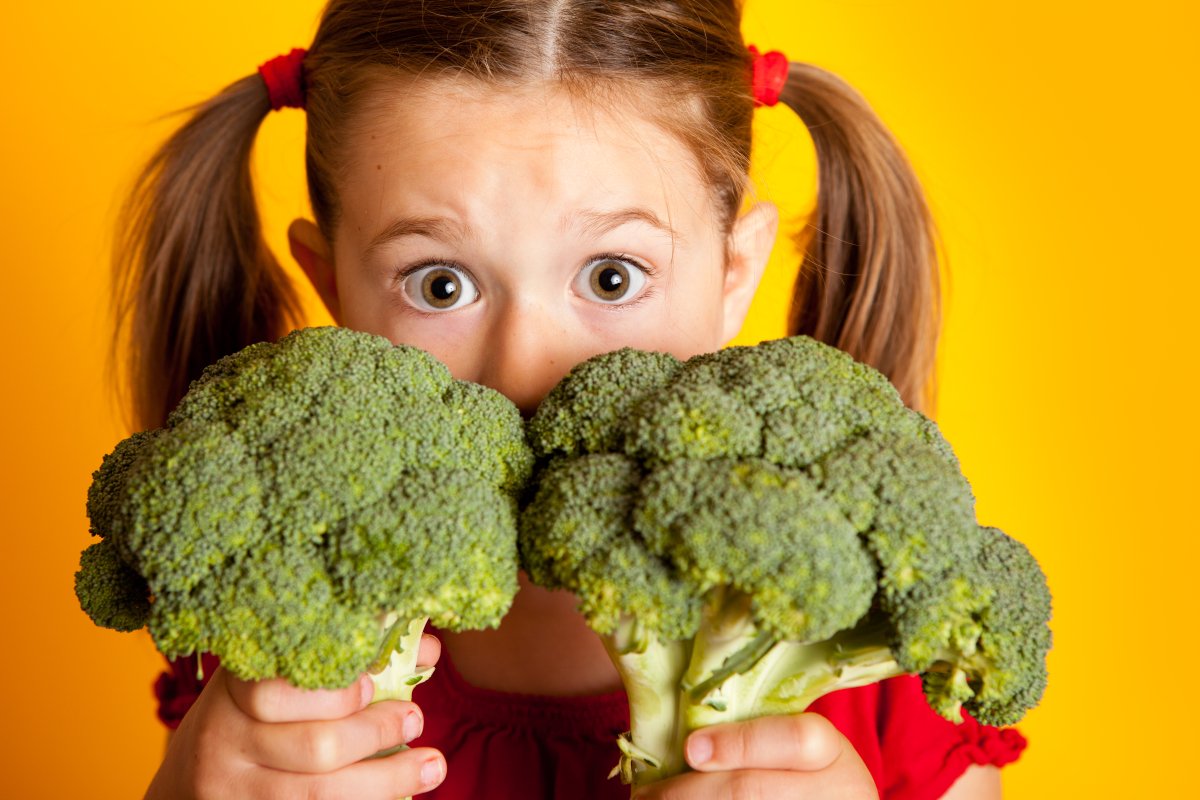We all know that vegetables are good for us. And with a few simple tricks, you can help the little ones in your life eat more plants — a healthy habit that will serve them for their entire lives. Healthy eating for kids is easier than you think!
By Lauren Panoff, MPH, RD
Wish as we might as parents, grandparents, aunts, uncles, siblings, teachers, or friends, most of the kids in our lives may not have learned to love fresh greens and other veggies. They may have even learned to push them away, in favor of the many kinds of tasty junk food that seem to be everywhere today.
And if you’re like most adults, chances are you remember when your list of favorite foods as a kid was made up of pretty much anything but vegetables.
I’m a registered dietitian and a mom of two healthy, plant-based boys, but that certainly doesn’t mean my family has been immune to the common challenges of feeding kids healthfully. My three-year-old son, for instance, would probably subsist on bread and crackers if he had his way!
Challenges to Feeding Healthy Kids
There are a lot of factors that work against prioritizing healthy eating for kids today.
Given the landscape of the current food system, it’s no wonder so many kids develop eating patterns that lack whole fruits and vegetables.
Only 3% of American adults eat the recommended minimum amount of fiber, a nutrient only found in plant foods. As such, many children grow up accustomed to eating the Western Diet — a way of eating known to increase the risk for chronic diseases — rather than a diet based on healthy, whole, and minimally processed plant foods.
As challenging as it can be to expand and improve a child’s palate, it’s feasible with the right perspective and persistence.
Healthy Eating for Kids: 7 Tips to Get Them to Eat More Plants

With a few tweaks to your family’s mealtime habits, you can raise kids who enjoy many fruits and vegetables. Here are some tips to help you:
Note: I’m a mom, and for the sake of simplicity, I’m writing as if you’re parenting children, too. But whether or not you care for small people, if you have kids in your life, I think you’ll find valuable insights below. Some of these tips might even help persuade your “inner child” on a more veggie-loving path!
#1 — Remember Your Role at Mealtime as a Parent
If you lean toward a type A personality, as I do, it can be hard to loosen the reins when your kids don’t want to eat their green beans. Personally, I’ve found that Ellyn Satter’s Division of Responsibility in feeding is an excellent perspective to adopt in this situation.
This approach says that as a parent, your job is to serve healthy foods and provide enjoyable and supportive eating experiences. Period. Your children’s job is to decide what and how much of it they eat, to behave appropriately at mealtimes, and to grow accordingly. You get to serve the plant foods, and they get to explore them.
This approach requires patience but can minimize mealtime stress for both you and your children, allowing for healthy eating habits to develop naturally. It’s also been shown to help your kids become “eating competent,” meaning they learn to intuitively eat the amount they need and grow as nature intended.
I used to have a major internal struggle when my kid would only eat one thing on his plate and leave the rest. We tried bargaining (“Just take two bites of potato, and then you can be done.”), bribing (“If you eat your noodles, you can have dessert.”), and demanding (“Eat it, or [insert consequence here].”).
Good nutrition is a priority for me, so it’s been hard for me to give up this control. But I notice that when I don’t put so much mealtime pressure on my son or myself, we get a much better result. And I know that this way, in the long run, he’s going to have a healthier and more authentic relationship with food.
#2 — Introduce Foods Again and Again
Just like potty training, putting on their own shirt, or learning to ask for something without yelling, kids may take a while to try something new on their plate.
You may need to expose your children to a food five to 10 times before they decide to even try it. Even then, they may need to taste it a few times to decide whether they like it.
My one-year-old likes to examine new foods with the “poke test,” eating things he knows he likes and poking anything unfamiliar with his finger (often before throwing it on the floor). It may take a few introductions, but eventually, new foods do reach his mouth. And then, we celebrate.
You can introduce the same foods in slightly different ways, too. For instance, I’ve served spinach steamed with garlic, sauteed with nutritional yeast and cashews, and even raw with a salad dressing as a dip (my preschooler actually requests this now!).
And I’ve served canned beans mildly seasoned with cumin, mashed onto a tortilla with avocado, and roasted (chickpeas are best for this). I’m learning to be consistent, and trust the process.
#3 — Present Plant Foods in a Fun Way
I can’t be the only adult that would rather eat something cute or colorful than something that looks like dull slop. Kids, too, are more likely to be drawn to foods presented to them in an intriguing way.
This doesn’t mean you need to go get a culinary degree. Something as simple as serving a rainbow of raw vegetable sticks — like red bell peppers, orange carrots, and green broccoli — alongside a dip can be enticing for kids.
And if you’re feeling more creative, displaying food in fun shapes or designs can do the trick.
I’ve made bear-shaped pancakes full of ground flaxseed and used blueberries for the eyes and mouth. I’ve also gone old school by serving “ants on a log” (celery sticks with peanut butter and raisins). “Banana boats” are another common snack in our house. I’ll slice a banana in half, lengthwise, spread it with sunflower or almond butter and sprinkle it with chia or hemp seeds.
#4 — It’s Okay to Take a Sneakier Approach Sometimes
Let’s be honest — hiding fruits and vegetables is probably a skill every parent should master, regardless of what diet you follow.
I’ve found this to be especially helpful during the “picky eater” phase that many toddlers go through as they start to establish their autonomy. Fortunately, this doesn’t last forever. And experimenting with different ways to serve nutritious foods during this time is nothing to feel guilty about.
Carrots, apples, zucchini, bananas, berries, and even leafy greens can be pureed and blended into muffin or pancake batter before baking. Smoothies are a fantastic, kid-friendly vehicle for nutrition.
Sometimes, I’ll add beets to a fruit and ginger smoothie. Not only does this create a fun, magenta hue that my kids find appealing, but it also adds extra vitamins and minerals. During the summer, homemade fruit popsicles (e.g., blended coconut milk, berries, and a pinch of maple syrup) are another favorite.
Another option is to make common “kid foods” healthier by subtly adding plants. Baked veggie-packed tater tots or mac and “cheeze” with peas and carrots are popular in my house. You can even substitute grain-based pasta with legume-based pasta full of plant-based protein.
#5 — Involve Kids in Meal Planning and Preparation
Most kids enjoy activities that nurture their independence, especially when it comes to food.
My preschooler loves picking out a new fruit or vegetable when we go grocery shopping. He anxiously awaits for it to ripen at home on the countertop.
How did this come about? I hardly ever get to grocery shop by myself, so when he started trying to grab junk food off the shelves, it was time to implement a new tradition. By allowing him to pick out a new food that he wants (with boundaries), it’s a win-win. He gets to feel independent and empowered, and I get a kid who learns to eat healthy foods regularly at a young age.
As they get older, you can assign your kids to different meal preparation jobs. My preschooler also enjoys rinsing vegetables and mixing batters with a wooden spoon. His favorite role is, of course, the taste tester (except for maybe the time he tried drinking vanilla extract!).
You can also include kids in meal planning. Asking your kids what dinners they would like shows them that their input is important, which can make them more interested in eating foods they had a say in. You could even look through a cookbook and choose a new plant-based recipe together.
As they get older, they may be able to prepare recipes by themselves, too. Here are a couple of fun children’s cookbooks: Eat Your Greens, Reds. Yellows, and Purples and The Help Yourself Cookbook for Kids.
#6 — Speak Positively About the Foods You Serve
Children mimic their parents, and this is also true around the dinner table.
Confession: I have a strong aversion to rutabagas and turnips. Even though I don’t serve these foods to my kids, it’s best for me to keep this opinion to myself. I don’t want to influence their likes and dislikes before they try them on their own (probably somewhere other than our house!).
Instead, engage in family conversations around what new plant foods look, feel, smell, and taste like. And when it comes to healthy foods, if you don’t have anything nice to say, you might not want to say anything at all.
#7 — Make Mealtime Educational, Too
I know, this one sounds boring, but hear me out.
One of the first questions that almost every kid loves to ask his or her parents is “Why?” Kids are natural scientists, constantly exploring the world around them. They may want to understand the reasons behind things you’re teaching them to do (or not do), and mealtime is an excellent learning opportunity.
Work to help your kids enjoy the plant foods they’re eating, but also teach them why these foods are good for them.
One way I do this is by fostering mealtime conversations that matter. Our family goofs around a lot (which I believe is equally important!), but mealtime can also be a perfect teaching moment for healthy eating habits. For example, if we’re eating roasted broccoli, I might ask my son if he knows what makes broccoli so super cool, and then enlighten him with a fun fact from his nerdy mom. (For my answers to commonly asked questions about plant-based nutrition for kids, see this article.)
This can then turn into a simple lesson about healthy foods. For instance, offering a comment like, “Did you know that eating carrots helps your eyes see better at night?” or “Beans are full of protein, which helps you build strong muscles like Superman!” Or, share a fun fact about the plant food, like “One strawberry can have 200 little seeds on it!” and give them a little magnifying glass to take a closer look.
Healthy Eating for Kids: It’s All Worth It in the End

Raising kids comes with enough challenges without adding extra stress in teaching healthy eating habits. But by incorporating some of the tips outlined above, you can have your children — and your entire family — enjoying an increasing variety of healthy plant foods. And this is a skill that will serve you all for a lifetime.
Tell us in the comments below:
-
What do you think of these ideas?
-
How do you get kids to eat more plant foods?
-
What are your experiences with healthy eating for kids?
Featured Image: iStock.com/ideabug


